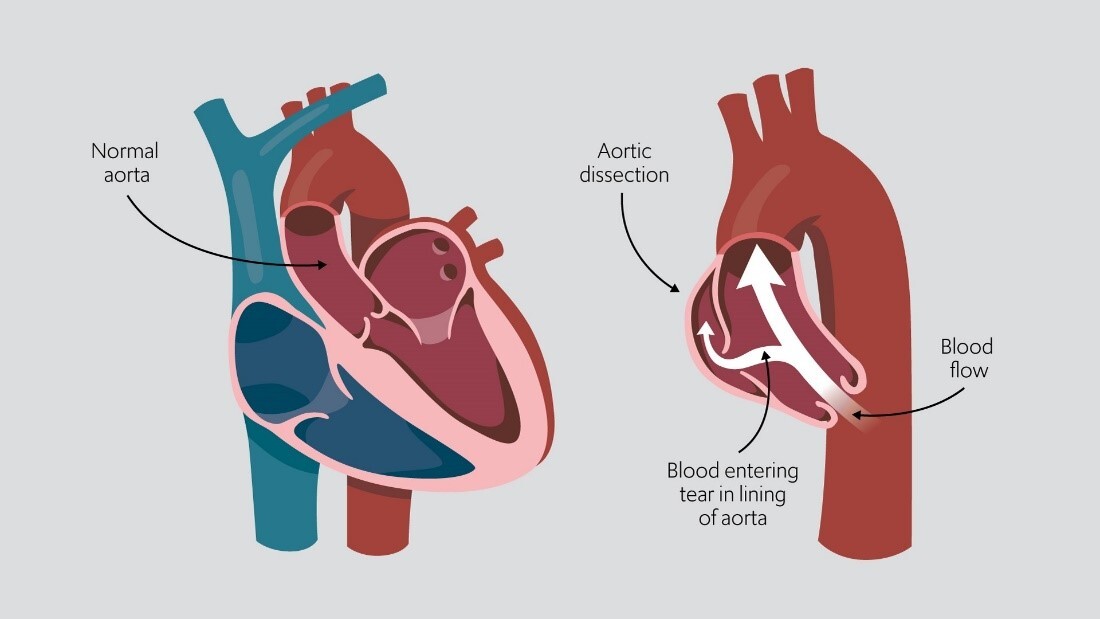The type of aortic dissection affects the way the condition is managed and the prognosis. Specialists classify aortic dissection according to its location in the aorta. In this article, we’ll explore the different aortic dissection types and what they mean for your health and treatment.
What is the aorta?
“The aorta is the major artery that carries oxygen-rich blood away from the heart to the rest of the body. It connects to the heart’s left ventricle via the aortic valve,” explains consultant vascular surgeon, Mr Maziar Mireskandari.
“The aorta is shaped like a candy cane, first arching up (the ascending aorta) and then descending (the descending aorta) through the chest and abdomen.”
“The aorta links to other major arteries, allowing them to deliver blood and oxygen to your organs, muscles and other cells. If you have a problem with your aorta, it endangers the health of your heart and jeopardises the blood supply to your whole body.”
What is aortic dissection?

Aortic dissection is a life-threatening condition caused by the weakening of the aorta wall. The inner (intimal) layer of the aorta tears, and blood flows through the tear, splitting the intimal layer from the middle layer of the aorta. This split is known as aortic dissection. Aortic dissection can develop suddenly or slowly over time.
What are the types of aortic dissection?
Aortic dissections are divided into two main types according to the part of the aorta affected:
- Type A aortic dissection.
- Type B aortic dissection.
Aortic dissection type A
“Type A is the most common type of aortic dissection, affecting twice as many people as Type B. Type A aortic dissection is located in the parts of the aorta nearer to the heart. It involves a tear in the aorta where it exits the heart, in the ascending aorta or the aortic arch,” explains Mr Mireskandari.
Type A dissection is the more dangerous type because the risk of rupture is high. If you have Type A aortic dissection, you will usually need surgery to repair the aorta. If the aortic valve is affected, you may also need an aortic valve replacement.
Aortic dissection type B
“Type B aortic dissection is usually less dangerous, and the risk of rupture is lower. The tear is located in the lower part of the aorta, known as the descending aorta,” explains Mr Mireskandari.
If you have a Type B dissection, you may not need surgery. Your specialist may be able to manage your condition by reducing the strain on your aorta by controlling your blood pressure with medication.
How to diagnose aortic dissection type
Your specialist team will diagnose aortic dissection based on your symptoms, medical history and a complete examination. They will arrange a range of tests and investigations to confirm the diagnosis, identify the type of aortic dissection, and help them differentiate between aortic dissection and other serious medical conditions, such as a heart attack, which may have similar symptoms.
Diagnostic tests could include:
- ECG: An electrocardiogram records the heart’s rate, rhythm and electrical activity. The ECG can check if you’re having a heart attack. Around one in five people with Type A dissection also show signs of reduced blood supply to the heart muscle on their ECG.
- chest X-Ray: There may be characteristic changes, but a normal X-ray does not exclude aortic dissection.
- transthoracic or transoesophageal echocardiogram: An echo is an ultrasound of your heart and valves. The scanner can visualise the area either across the chest wall or from inside the gullet, which can provide better views. The echo will indicate the site and size of dissection.
- CT scan: Computerised tomography can confirm the diagnosis of dissection if it is uncertain.
- MRI scan: MRI scans provide excellent images of the aorta. They can confirm dissection and check if any blood vessels are affected. Research suggests that it is the most accurate test, with both sensitivity and specificity of 98%.
- colour flow doppler: A doppler looks at sound waves and can check if there’s aortic valve damage, causing blood to leak backwards into the heart (aortic regurgitation).
Aortic dissection treatment
Early diagnosis, quick decision-making, and prompt, effective treatment are crucial when managing all types of aortic dissection.
The treatment of aortic dissection depends on the type of disease. If you have a Type A dissection, you are likely to need urgent surgery; a Type B dissection may be managed with medication and close monitoring. The management includes:
General measures for aortic dissection
If you have a dissection, you will need intensive medical support in an ICU or high dependency unit to replace lost fluids, monitor your vital signs and organ function, and relieve pain.
Medical treatment of aortic dissection
Medical management of aortic dissection aims to reduce the strain on the aorta to prevent further damage and bleeding.
The specialist team will aim to control the blood pressure and reduce the force exerted when the heart pumps. They will use intravenous beta-blockers, sometimes combined with drugs that relax and open up the blood vessels.
Surgical treatment of aortic dissection
The cardiothoracic or vascular surgeon will tailor surgery using the results of your investigations. Surgery will depend on the size, site and severity of the dissection and your general health.
For acute Type A dissection, the surgeon will aim to prevent the aorta from rupturing and replace a faulty aortic valve. Surgery can include repairing or replacing the damaged part of the aorta, stents or grafts, and they may consider replacing part of the aortic arch.
For Type B aortic dissection, the surgeon may recommend open surgical repair. However, they may perform thoracic endovascular aortic repair or TEVAR. TEVAR is a minimally-invasive alternative to open surgery. The surgeon places a stent inside the aorta, accessing the area through blood vessels in your groin and arm. When used with medical treatment to control blood pressure, TEVAR appears to give better outcomes than drug therapy alone.
Related content
-
Aortic dissection
Aortic dissection is when the aorta tears causing blood to rush through.
-
CT scan
A CT uses X-rays and a computer to produce images of many structures inside the body.
-
MRI scan
An MRI scan is a medical imaging technique that uses a magnetic field and radio waves to create pictures of an internal cross-section of the body’s structures.
-
Thoracic endovascular aortic repair (TEVAR) procedure
TEVAR uses a stent-graft to reinforce and repair a weakened section of the aorta.

